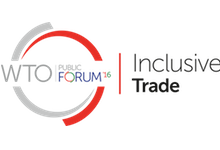How to transform e-commerce into global e-trade
29 Sep 2016 13:00h - 14:30h
Event report
[Read more session reports and live updates from the 2016 WTO Public Forum.]
This session, organised by the American Chamber of Commerce to the EU (AmCham EU), and moderated by Carsten Dannhöl, the EU Government Affairs Manager at Caterpillar and Vice-Chair at AmCham EU Trade and External Affairs Committee, focused on the distinction between e-commerce and e-trade. E-commerce is seen from an individual perspective, linking one actor with one website, while e-trade has more of a global dimension, with several implications, including customs and import-exports. Dannhöl noted that data is a specific challenge for smaller companies that are not engaged in e-trade, and the idea is to demonstrate how e-commerce would enable more inclusive trade.
Torbjörn Fredriksson, Chief of the ICT Analysis Section at the United Nations Conference on Trade and Development (UNCTAD), underlined that there is a need for more statistics to fully understand business-to-business (B2B) transactions and where the main gaps are. Such information would help develop e-commerce more efficiently, especially given that there is still a huge divide between countries. Fredriksson noted that the international community should enhance its efforts to assist these developing countries in order to encourage and promote e-commerce in a more extensive way. He emphasised that ‘we need the perspective of developing countries and developed countries, no matter the size of the players’. Fredriksson also identified several areas where the international community can make a difference. These include: payments, trainings, and financing of start-ups in the area of e-commerce. Many policy makers in developing countries feel uncomfortable when it comes to e-commerce, mainly because they do not fully understand the issues at hand and because they may not know where they stand in the digital economy.
Hamish McCormick, Ambassador and Permanent Representative of Australia to the World Trade Organisation (WTO), and Chairperson of the WTO Council for Trade in Goods, reminded some of the fundamental objectives of the WTO, including the removal of economic barriers, or when that is not possible, ensuring more transparency. Regarding the removal of trade barriers, he noted the need to liberalise regulations that limit trade, and make them less restrictive. McCormick also underlined the importance of building confidence in trade, an aspect which was also mentioned by the following speaker of the panel.
Gustavo Miguel Vanerio Balbela, Ambassador and Permanent Representative of Uruguay to the WTO, and Chairperson of the WTO Council for Trade in Services, said that e-commerce and e-trade are growing fast and need to be dealt with in every country and by every member of the WTO. They should see this rapid growth as an opportunity to be seized. Vanerio Balbela insisted on the necessity of identifying the issues at stake in order to bring more convergence, as well as a sense of general trust in order to ensure consumer protection. He noted that confidence is essential to the growth of e-commerce.
The last speaker of the panel, Mark van der Horst, Director of EU Public Affairs, UPS Europe, and Chair of AmCham EU Trade and External Affairs Committee, explained that smaller companies need assistance in order to engage in e-commerce, so that they too can capture the potential of exports. An analysis of the conditions needed to facilitate access to e-commerce (such as facilitating customary procedures) could be useful in this regard.
by Ana Andrijević
Related topics
Related event

